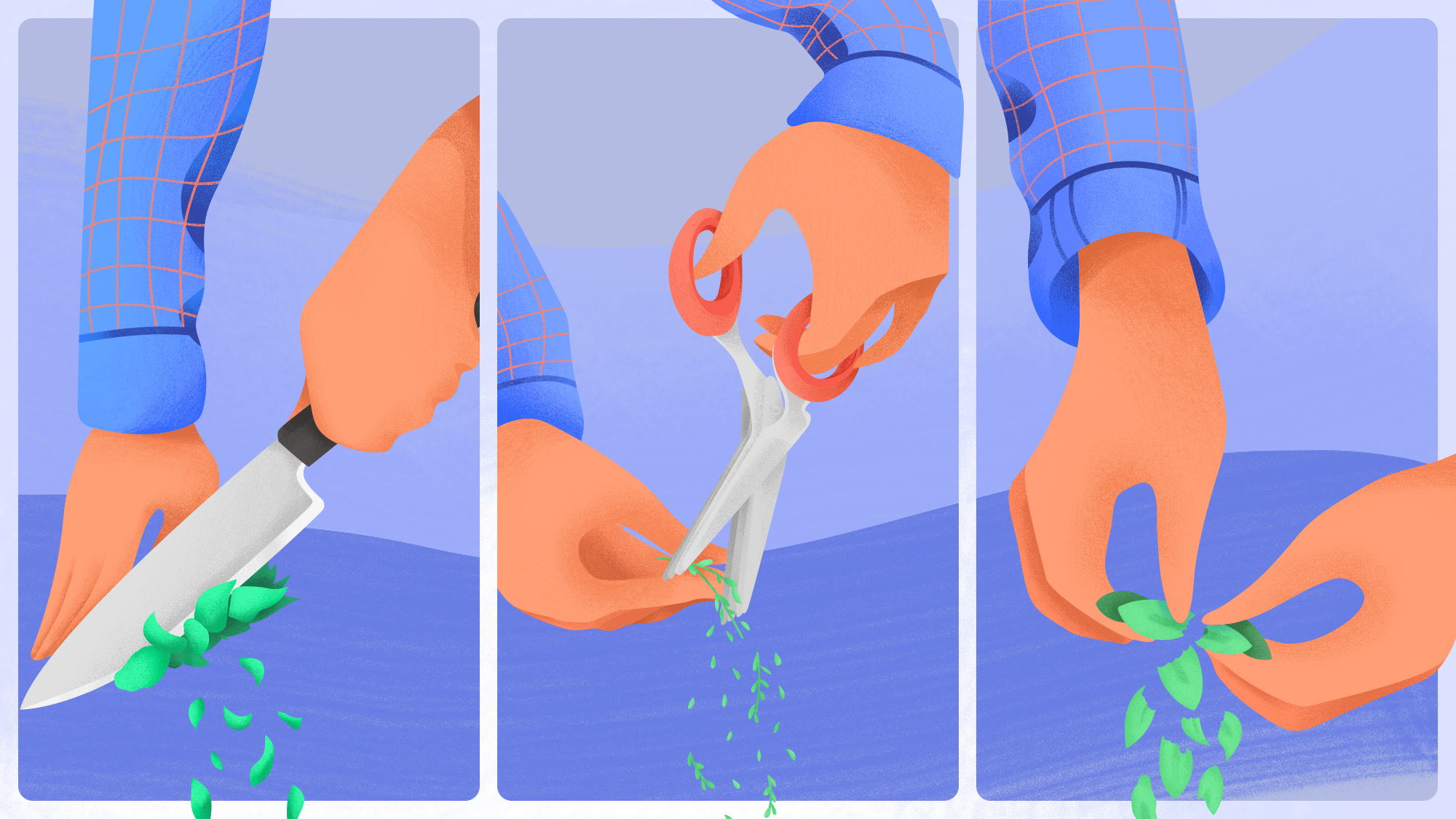Which Summer Greens Should You Tear, Snip, Or Chop?
We may receive a commission on purchases made from links.
Summer approaches, and many of us start frequenting farmers' markets or even trying out our own green thumbs in the backyard to take advantage of fresh produce for a few months. But this concentrated warm-weather salad preparation always leaves me a tad confused: I know there are some things I should tear to avoid bruising, and some herbs I should snip with scissors instead of slicing, but I can never remember which sharp object to use for which. So I turned to the experts: What green things should get torn, snipped, or cut?
Tear: Lettuce and leafy greens
Chef Ann Nolan, culinary training chef with KitchenAid, was extremely helpful. She said: "I have always said that your hands can be your best tool." More specifically, "I have always torn leaf lettuce, romaine lettuce, and kale. Many times when you cut lettuce, it will get 'rusty' on the edges. My mom always tore the lettuce and kale and I have continued doing the same way because I like the results."
Martin Bolanos, executive chef of Ouisie's Table Restaurant & Gardens in Houston, agrees: "In preparation for salads, I always tear Boston lettuce, mustard greens, and pomegranates by hand. Tearing brings the flavors out in the greens."
Executive chef/owner Joe Frillman of Daisies restaurant in Chicago, goes past the tearing of greens: "We tear most of our herbs because we don't want to bruise them. Basil and mint are the biggest as they bruise very easily, and cannot be cut ahead of time as they will turn brown. We will pick dill and cilantro and tarragon and use them torn or whole quite a bit."
Snapping is another way to use your hands as a tool, as A.J. Walker, chef de cuisine at Publican Anker in Chicago, suggests a special way to deal with asparagus: "I always recommend snapping asparagus by hand instead of cutting, since the applied force causes the stalk to break at the natural point where it starts to get woody and fibrous. If you're slicing it with a knife, there's a chance you might miss the mark and end up with tough asparagus in your salad."
Snip: Herbs
While Frillman likes to tear delicate herbs, many of the chefs I talked to favor scissors instead. KitchenAid's Chef Nolan commiserates. "This is one question that people go back and forth about. It's easy to use a sharp scissor to snip the herbs that go into a dish. It's fast and easy. For instance, chives are easily cut up using a scissors. You can have a bunch of chives in your hands and then start snipping away. I also find it easy to chiffonade (French for ribbons) with basil using a scissors. I will lay three or four leaves of basil on top of each other and then roll them into a cigar. Then I start snipping the rolled-up basil into thin pieces directly over the dish I am garnishing, like a pasta dish, and then serve immediately." Sounds like a much better process than chopping on a board and then transferring over the herbs, especially if you're me, a person who can never have too much basil.
Genevieve Guy, owner/chef Bistro Provence in Houston, is also enthusiastic about using scissors with herbs. "We bring in a lot of our herbs from a garden in back of the restaurant. For all of those, like basil, chives and green onion stalks, I always use very sharp scissors. You want them the correct size but you don't want to crush them, which too often happens if you chop them with a knife." Bolanos uses, "snippers on grapes, mint, rosemary and basil from our gardens." Frillman is a bit more specific, using scissors for a particular type of salad: "Scissors are mostly used for frisée. The delicate chicory necessitates a finer instrument to trim off all the extra bitter green parts, and get into the pale yellow center head of it and cut small uniform pieces."
Chop: Vegetables
As you might expect, larger items like most vegetables can't get the tear or scissors treatment. "Most vegetables are cut using a knife. Broccoli, cauliflower, Brussels sprouts, carrots, onions, turnips, peppers, radishes and potatoes, as examples," Nolan explains. Bolanos adds, "Peppers, shallots, beets, mushrooms, onions and other similar things are chopped using a knife."
The above categories are broad, obviously: Many of these chefs had different blades for different categories; some liked cutting herbs with knives, or tearing (like Frillman), and some liked chopping certain lettuces. But because I'm not a chef, and am basically looking for an easy way to get through my salad-filled summer, I'm going to go with majority rule and follow the guidelines above. I also might try to up my cutting education even further this summer, as Nolan leaves us with this final thought: "If you want to change your life in the kitchen, take a knife skills class. You will be taught how to use a knife, mostly a chef's knife, and how to cut up vegetables, fruits and herbs. There is a certain way you cut each of them. Once you learn the tricks, your adventure in the kitchen will begin."
